
Volume 14 - Autumn 2002
Antarctica - A 'Journey' in Book Production
by Pat & Rosemarie Keough
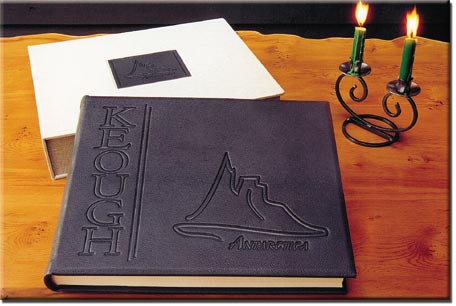
Almost a decade ago, we had a dream of creating the world's highest quality books as an innovative way to leverage our personal capital and talents towards supporting worthy conservation and social causes. The dream became a goal, and the search for excellence in book production became our obsession.
We knew a lot about commercial books, having released six titles featuring our photography including The Nahanni Portfolio and The Niagara Escarpment: A Portfolio. Frustrated with the many quality compromises inherent in producing trade books, we decided to leap into the unknown and create a new genre of ultra-high quality art books.
ANTARCTICA: Explorer Series, Volume 1 is the result. This luxurious masterpiece is limited to just one full-leather, morocco-bound edition of 950 books plus 50 proofs. The book in its presentation box weighs 12.5kg. The world's most advanced technology has gone into printing ANTARCTICA, and the edition is exquisitely sewn and bound by hand. Published from our Salt Spring Island studio in British Columbia, Canada, ANTARCTICA is attracting global attention and winning international awards.
The Art of Outstanding Hand Binding
Goat leather is strong, abrasion-resistant and durable. This is the traditional choice for fine binding. In fact, the goat leather covers of thousand-year-old books such as those of the Sinai's St. Catherine's Monastery are in relatively good condition to this day. Whereas modern limited-edition books are often bound in quality cloth or sometimes "quarter bound" in leather, ANTARCTICA is fully bound in morocco goat, among the most expensive of book leathers. ANTARCTICA is so large that two full skins are used to bind each copy. ANTARCTICA's custom-dyed Chieftain Goat from Hewit first received a vegetable tannage, followed by a newly developed archival process that neutralises the effects of humidity and atmospheric acids from air pollution.
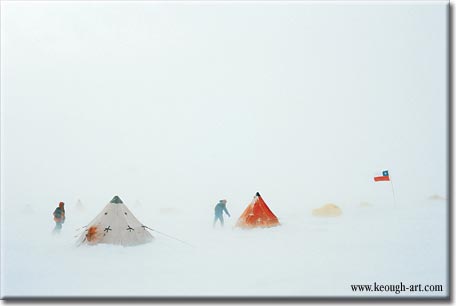 Blowing
Snow, Patriot Hills
Blowing
Snow, Patriot Hills
We did consider other leather options. A few binders who specialise in the leather binding of accounting and legal books suggested upholstery or garment leather, of which there is a myriad of choice and price. However, we soon realised how inappropriate these leathers are for fine hand binding. For starters, usually such leathers have too much stretch and thickness for bookbinding. When cow leather, for example, is skived to the 1.0mm thickness required for fine binding, it loses nearly all strength. Also the common chrome-tanned leathers, which are specific to end uses such as sofas, chairs, shoes, jackets, gloves or suitcases, are not archival. Certainly there are rich calf leathers available for bookbinding, but we ruled these out because calf marks so very easily, especially considering ANTARCTICA's weight. Sheep leather, another possibility, can delaminate - a risk we were not prepared to entertain.
We asked the tanneries to recommend the world's leading hand-binderies. We quickly learned that while there are many one- and two-person binderies that specialise in restorations or designer bindings, such craftsmen would require five to 10 years to bind our entire edition. Eventually, after visiting several medium-sized binderies across North America and commissioning numerous prototypes, we awarded our contract to Felton Bookbinding Ltd. of Ontario, Canada.
Master binder Keith Felton is a dedicated artisan, committed to tradition while being innovative and open to new ideas. Keith worked with us for over a year perfecting the design of the binding. Numerous full-size books were bound to test and evaluate each variable; for example, the thickness of the Irish linen thread so as to judge the effect on the swelling of the spine and thus the tightness of the binding. Irish linen thread was selected for the hand sewing of this book because of its archival properties. Additionally, linen does not stretch through time. Thus the tension of the 288 stitches and numerous knots found in each copy of ANTARCTICA will remain constant.
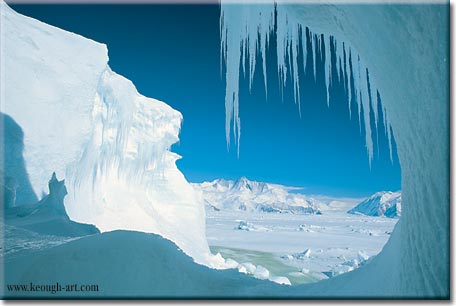 Moubray
Bay, Mount Hershel and Ironside Glacier, Victoria Land
Moubray
Bay, Mount Hershel and Ironside Glacier, Victoria Land
We paid particular attention to the reinforcement of the book's physical structure, given that ANTARCTICA weighs about the same as a two-year-old child and that the format is landscape in orientation. The traditional split-board construction proved ideal for strength and durability. The split board is a historic binding method invented so that books would not come apart, especially heavily used books such as accounting ledgers, land title registries and library books of centuries past. While the pages are being hand sewn on a sewing frame, the thread is woven over four 2cm wide linen "tapes" in the spine. These tapes are later permanently sandwiched and glued between laminations that make up the cover boards. Short of purposeful damage, the pages cannot separate from the cover. Split-board binding, however, is utilitarian rather than stylish. Along with durability, we also desired the refined beauty of the classic European style of fine hand binding. Although binders told us that these two traditional styles are technically incompatible, Keith agreed to try to meet our wishes. After much effort, he was successful. As such, ANTARCTICA is the world's first book known to combine the best attributes of the split-board and classic European binding styles: strength and elegance.
Just what is the classic European style? Each book has a rounded spine that has been carefully hammered into shape with a special mallet and "backed with shoulders" so that the covers lie flush with the spine. Raised bands with flared edges give the spine a contemporary look. Noticeably absent from the covers is the French groove: a deep joint running alongside the spine on the front and back covers of split-board and also all machine-bound volumes that permits books to open readily. The skill of fine hand binding is to fashion a book that opens smoothly without the benefit of the French groove, as is the case with ANTARCTICA.
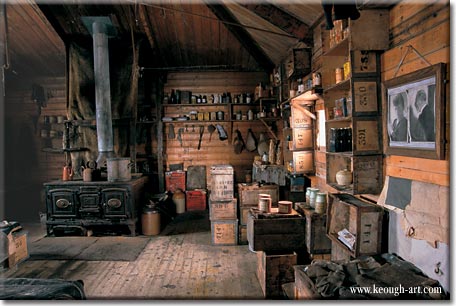 The
frigid, well-preserved interior of Shackleton's 1908 Nimrod Hut
The
frigid, well-preserved interior of Shackleton's 1908 Nimrod Hut
The inside of ANTARCTICA's deeply embossed covers is very special. The leather, drawn over from the outside, is precisely trimmed to a 2-cm (3/4") wide border. An inlay of velvet is fitted within these leather "turn-ins". The flush fit, without gaps or elevation differences, demonstrates the skill of the binder. This inlay, termed a "doublure," is completed by a "leather joint," which adds strength and beauty to the area where the flyleaf flexes. ANTARCTICA's leather joints also cover the emergence of the linen tapes from the spine side of the pages to the point where the tapes are locked within the cover boards. Of interest, whereas the flyleaf of ANTARCTICA is French flocked velvet on one side, the opposite is a textured paper printed with an abstract photograph of ice floating in the Ross Sea.
Many binding features grace ANTARCTICA. Without wishing to saturate the reader with details, the following are just a few final comments to further the appreciation of the bookbinder's skill. ANTARCTICA has a hollow back, which refers to the pyramid-shaped space that appears between the spine of the pages and the spine of the cover when the book lies open. The binder predetermines the amount that the hollow lifts, thereby controlling the degree to which pages lie flat while avoiding undue stress on the stitches. Nothing about ANTARCTICA has happened by chance; for example, because the hollow is partially visible from an oblique angle, the colour of the material selected to form the hollow matches that of the leather.
ANTARCTICA's decorative head and tail bands are black and white silk embroidered onto split cane. While rigid and robust, cane is also permanently flexible. When opening and closing ANTARCTICA, we always enjoy how neatly these bands tuck beneath the leather headcaps - the detail formed by drawing the leather over a length of rope along the top and bottom of the spine. The thickness of the rope was selected to approximate the 9-mm (3/8") thickness of the covers. Such minute attention was necessary to create this exceptional book. Then there is the sturdy Dutch linen presentation box that accompanies ANTARCTICA ... but that is another long story.
The Art of Outstanding Lithography
ANTARCTICA was awarded a coveted Benny - a distinction that is as important to the international printing and graphic arts community as an Oscar is to the film industry. This year the Printing Industries of America, host of the Prestige Print Awards competition, received 4,889 entries from 15 countries, among which ANTARCTICA was the most outstanding entry in its category. The Benny, short for Benjamin Franklin Award, recognises the world's best printing.
Why has ANTARCTICA won seven printing awards to date, including the Gold, People's Choice and Best of Show awards at the Gallery of Superb Printing competition in addition to the Benny mentioned above? Of significance, ANTARCTICA is the world's first photographic art book to be printed with 10-micron stochastic dots - leading-edge technology that has three times the resolution of traditional high-end lithography. What this means is that each individual dot of ink in ANTARCTICA is only one hundredth of a millimeter in diameter. To see the 10-micron dots that make up the images in ANTARCTICA, a 50-power magnification eyepiece is necessary. With normal printing, 15-power is sufficient.
Previously we have printed books in Japan and Canada. For ANTARCTICA, we were prepared to contract a printer located anywhere in the world, so long as the firm was the best. We approached paper manufacturers to ask which printers were winning major awards, and then requested samples and quotations from 20 candidate firms. We visited each of the printers that made our short list, and insisted that they print four representative pages from ANTARCTICA on the actual production press that would be used for the entire book. Once the tests were completed, we compared the results side by side, spread across our studio floor. The best quality, defined as the highest resolution and most accurate colour, was supplied by Hemlock Printers Limited, British Columbia, Canada.
The reason for this spectacular difference is that Hemlock was beta-testing the new 10-micron technology developed by Creo Inc., the industry's leading innovator. Creo's international headquarters is located in Canada. At the time ANTARCTICA was printed, Hemlock Printers was the only firm in the world licensed to use this high-resolution technology, which is not only extremely sharp but also captures every nuance of colour, resulting in exceptional saturation as well as accurate detail for both shadows and highlight areas. The hardest shades to print are neutral greys and white, shades that are exquisitely reproduced in ANTARCTICA.
The Art of Photography
We have been professional photographers and publishers for 20 years, and 90,000 copies of our earlier books are in people's homes around the world. We have been involved with conservation videos, award-winning television programs and even postage stamps. Having determined that ANTARCTICA would be the first volume in our Explorer Series, we then dedicated two austral summers - November through March - to explore and experience this frigid wilderness. During this period we each used almost 400 rolls of slide film.
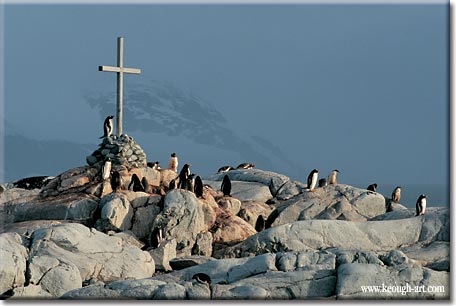 Gentoo
Penguins and memorial cross, Petermann Island
Gentoo
Penguins and memorial cross, Petermann Island
One of our hardest jobs was to select the final images for this book from among the many that were taken. For the design of individual page layouts and the flow of the book, we sought a balance between wildlife species, the multiple shapes of icebergs, the variety of landscapes and atmospheric conditions, and the hand of man. Geographically it was important to have equal representation of the windswept polar plateau, the majestic, mountainous coast, the off-lying islands and the surrounding icy seas. The images in this book are acknowledged by experts at the British Antarctic Survey, Scott Polar Research Institute, Scientific Committee on Antarctic Research and The Explorers Club as the most impressive and evocative collection of photographs of Antarctica ever published.
There are a great many stories we could share about our experiences in Antarctica, which we cherish all the more because our young son accompanied us on numerous expeditions. There are stories about the Save the Albatross campaign, the conservation effort to which we have pledged all net profits. There was the thrill we felt when we received confirmation that HM Queen Noor of Jordan agreed to personally sign each book in her capacity as president of BirdLife International; and our pride when ANTARCTICA was unveiled at a reception hosted by HRH Prince Charles at his home, St. James's Palace. Along with the glamour, the creative journey also had the usual number of setbacks, which were overcome through perseverance complemented by valued help from many friends.
Regarding our effort to create and release the Explorer Series, we share the philosophy expressed by Norway's Liv Arnesen; the first woman to ski unsupported to the South Pole. "To fulfil a dream, it must be converted into a goal, so that one may start planning. Hard work then follows. Most ambitions can be realised, so long as your motives are strong enough and genuine."
Pat & Rosemarie
Keough
Photographers, Writers and Publishers
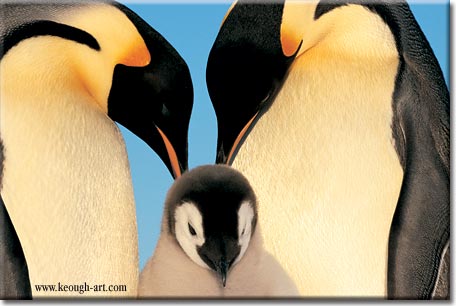
Emperor Penguins, Adults & Chick
ANTARCTICA:
Explorer Series, Volume 1
limited edition, 950 copies signed and numbered plus
50 proofs
$2,900 US
Nahanni Productions Inc.
400
Meyer Road, Salt Spring Island
British Columbia
Canada V8K 1X4
Tel: 250-653-4993, Fax: 250-653-4994
Web: www.keough-art.com,
e-mail: info@keough-art.com
